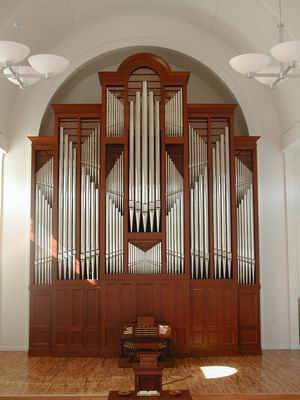 |
|
 |
|
|
On a stormy night in August 1998, a spark from a bolt of lightning ignited old timbers and a hidden fire burned undetected for almost five hours. By morning, nothing but four stone walls were left standing of the historic 136 year-old First Congregational Church. Not only did the members of this college community's congregation lose their building, but also lost in the fire were the church's large Aeolian-Skinner organ, which had been assembled in the mid-fifties by the Boston firm utilizing large sections of previoius instruments the church had owned over its many years, a just-acquired concert grand piano, together with one of the most comprehensive choral music libraries to be found in Southern Wisconsin. Henry DeBruyne, the congregation's director of music and organist for almost four decades, whose complete music collection was housed at the church, found he had nothing left following the fire. Not to be deterred, members of the congregation, under the leadership of its former minister, The Reverend Dr. Richard E. Hotchkin, decided to build a new church and pipe organ. After much research, the Janesville, Wisconsin architectural firm of AYA Associates was engaged to design a place of worship, and the organ builder Rieger-Kloss Varhany, Krnov, Czech Republic, was commissioned to construct a new organ to specifications exceeding those of the former organ. Three years later, on August 12, 2001, First Church's congregation moved into their new edifice, built in the historic New England tradition, erected on the same spot as the former building. The new First Congregational Church Meeting House was dedicated on Saturday, October 13, 2001, led by its newly appointed minister, The Reverend Shawn Stapleton. The Rieger-Kloss organ was inaugurated on Sunday, October 12, to a standing room only audience in a recital by Merrill N. Davis III. Another large audience greeted the Ukrainian concert organist, Volodymyr Koshuba, when he performed November 27. Negotiations for acquiring and designing the new organ were handled by Euro Musik Corporation of Bloomingdale, Illinois, the Rieger-Kloss firm's exclusive importer for the North American continent, and its president, Matt Bechteler, together with Merrill "Jeff" Davis, artistic and marketing director, and William E. Gray, Jr., design and sales consultant. The organ's more than 3,800 pipes were voiced and finished by Jan Kostera, Jr., Frantisek Kutalek, and Tomas Fafilek over a two-month period. An additional crew of eight men flown from the Czech Republic erected the massive forty-foot high oak organ case and its three stacked levels of slider chests. All of the organ's façade pipes are made from a heavy cast alloy of 75% tin. Walker Technical Company of Zionsville, Pennsylvania provided the instrument's computer system with its 256 levels of memory, a full MIDI interface equipped with an instant playback sequencer, together with the three 32´ pedal flue voices, chimes, harp, celesta, and zimbelstern. There are several novel and interesting tonal design features incorporated into the Beloit instrument:
The Beloit Rieger-Kloss instrument has many other tonal highlights. The acoustics of the room, with its 55-foot ceiling, hardwood flooring, hard plastered walls and ceiling, are certainly no determent to the magnificent sound of the organ. First Congregational Church, Beloit, warmly welcomes organist visitors to come and sit down to play and experience their new organ; organist Henry DeBruyne and pastor Shawn Stapleton look forward to showing the organ to visitors. -Merrill N. Davis III
|
|